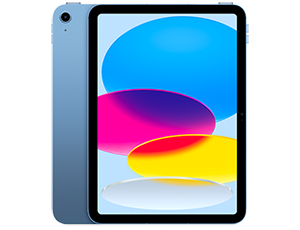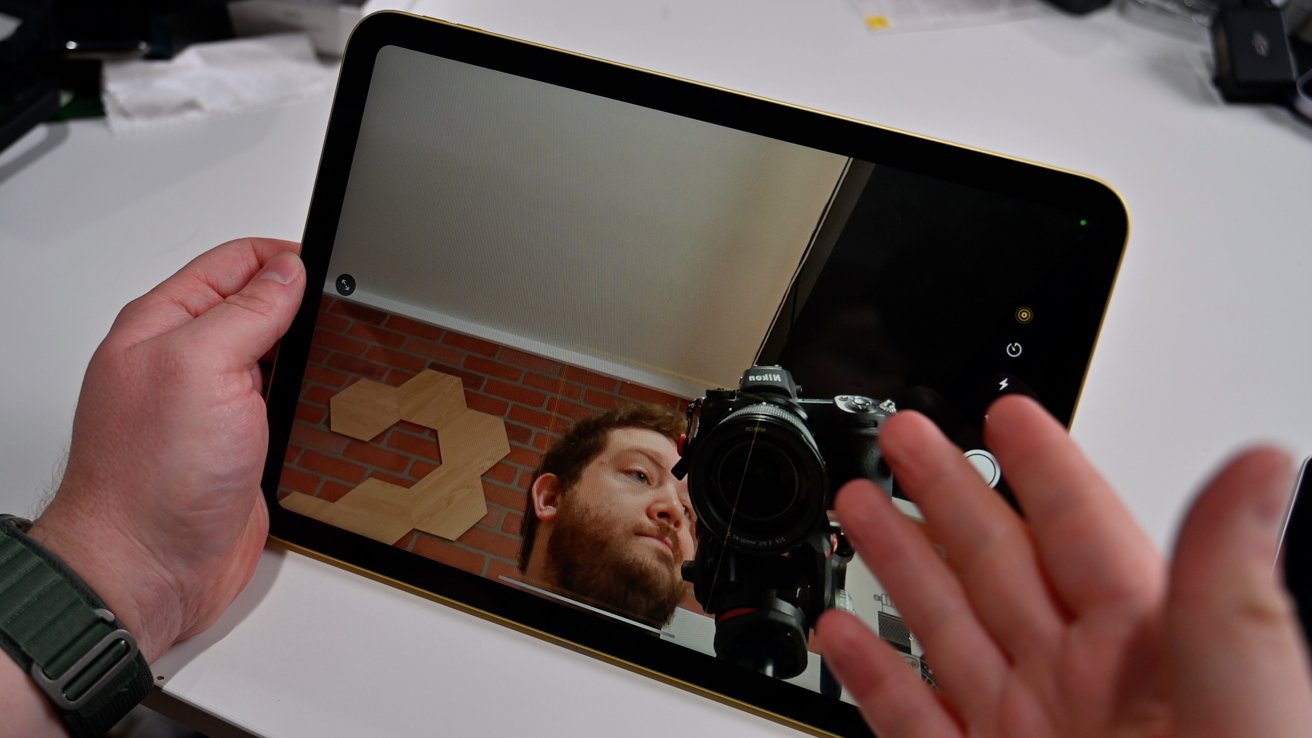Apple's 2022 iPad overhaul is a modernization of the line, but introduces new issues.
Apple's iPad has been a staple of the company's catalog since its launch. The 2022 model migrates the 2018 iPad Pro design to the entry-level, and brings some other niceties to the line.
Instead of replacing the ninth-gen entirely, Apple is selling the ninth and tenth-gen models simultaneously. The 2022 model is also more expensive, so the previous model retains the role of the cheapest new iPad you could buy, for the moment at least.
So, the new iPad isn't strictly the entry-level model, nor the cheapest. And in a well-populated catalog that includes the moderately-priced iPad Air, iPad mini, and the iPad Pro line as well, the tenth-gen iPad has trouble fitting in.
More Pro-like iPad
The latest iteration of the iPad has finally ditched the previous design language that it has held on to for the last 12 years. Instead of being the out-of-place model that has kept the same visual identity over the years, Apple has moved to make it more like others in the range.
Design shifts flat sides on the aluminum body, not dissimilar to the first iPad, minus the original's rear hump. And, it switches out the small camera on the rear for a larger one. Like the iPhone, the camera bump prevents the iPad from laying flat on a table without a case.
The display, which has grown from 10.2 inches to 10.9 inches, is also an edge-to-edge version with a reasonably slim bezel around the edge. The corners are rounded, allowing it to follow the lines of the updated casing.
To achieve this display style, Apple had to get rid of the front Home button but still retains Touch ID.
Apple pulls off a similar trick to the iPad Air and iPad mini, in shifting Touch ID to a top button. You're not getting an upgrade to Face ID on the iPad just yet, as that's still a premium feature.
At the same time it made the screen larger Apple also kept the iPad's overall footprint similar to the 9th generation. It's a little shorter at 9.79 inches compared to 9.8 inches, wider at 7.07 inches compared to 6.8 inches, and thinner at 0.28 inches versus 0.29 inches.
There's also been a bit of weight loss, with the Wi-Fi model now down to 1.05 pounds from 1.07 pounds. The Wi-Fi + Cellular is now at 1.06 pounds instead of 1.09 pounds.
Apple's Smart Connector is on the right side, well-positioned to connect Apple's new magic Keyboard Folio. This updated folio has a detachable keyboard and an integrated kickstand, though it isn't as lappable as the iPad Pro's Magic Keyboard.
We'll be talking more about this peripheral in the future. It's complicated.
Second screen change
It took until the seventh generation of the iPad for Apple to switch the display size from 9.7 inches to 10.2 inches. Three generations later, it has grown to 10.9 inches diagonal, and purged the Home button.
That extra size of the Liquid Retina display means more pixels to play with, at 2,360 by 1,640. The pixel density of the previous model is unchanged here, staying at 264ppi.
The new screen can output the usual 500 nits of brightness, which is good enough for most use cases. It also uses True Tone for environmental light matching, supports sRGB, and has a fingerprint-resistant oleophobic coating.
Apple made some design choices that we assume to maintain a lower price. The display isn't fully laminated, doesn't support the P3 wide color gamut, and lacks an anti-reflective coating — all of which are on the iPad Air.
Folks in the market for a budget tablet likely won't care as much about the lamination or P3 support, but the anti-reflective coating can hamper usability in harsh lighting.
On the other hand, non-laminated displays can be cheaper to repair. We'll see how this repair aspect shakes out over time.
Apple's decision to revamp the screen without making the overall tablet bigger gives an effect of the display being significantly more important than before. Without that Home button, it's also symmetrical, with less of an obvious at-a-glance indicator of orientation from the front.
This is a mixed bag for usability, considering where the front-facing camera is.
Camera size, camera placement
Apple made two radical changes to the iPad's camera system, covering both the front and back.
Around the back, the more visible change is that the small lens that sat flush with the back of the enclosure has grown in size. There's a good reason for the bump, as the camera has gone from 8MP to 12MP Wide with an f/1.8 aperture, a five-element lens, and Autofocus with Focus Pixels.
That camera has a 5x digital zoom, Smart HDR3, a 63MP panorama in software, auto image stabilization, and burst mode.
For video, the iPad finally gets 4K resolutions up to 60fps, up from the 1080p for earlier models. There's the usual 240fps 1080p Slo-Mo available, time lapse options, video image stabilization as well as 1080p Cinematic video stabilization, and continuous autofocus.
Taking photos with an iPad still looks ridiculous, but it happens. A higher resolution camera is always welcomed — and beyond just photos, it can improve the quality of scanned documents.
The biggest camera system change is probably the front-facing camera location shift. Instead of at the top side of the iPad display, Apple moved the front camera to the side bezel.
The change means the camera is on the center line when using the iPad for FaceTime calls in landscape orientation, while it is off to one side when held in portrait.
Apple now calls that selfie camera a "Landscape Ultra Wide camera," presumably branded that way because of its new positioning. Other than that, the front camera is the same as the Gen 9.
It's still a 12MP camera with a 122-degree field of view, an f/2.4 aperture, 1080p 60fps video, Cinematic video stabilization, and automatic image stabilization. If you're using it for FaceTime, you also have Center Stage support, which will keep you in the frame when moving around the camera's field of view.
Lightning Pencil, USB-C iPad
The switch from Lightning isn't unexpected, as other iPad models have already moved over, and the shift downwards was inevitable. It allows you to easily physically connect accessories like SSDs, microphones, or external displays with this common connector.
Unfortunately, the speed is terrible. While the rest of the line transfers at USB 3.0 speed or faster, depending on a large number of factors, the 10th generation iPad is limited to USB 2.0 speeds, the same as Lightning.
The iPad has only ever supported the first-generation Apple Pencil, and that has stayed the same here. And, that Apple Pencil retains its male Lightning connector.
Rumors about this iPad, and some early cases that shipped for it, assumed that the line would shift to the Apple Pencil 2, with magnetic charging and pairing. We presume that Apple didn't do this, as the pencil's inductive charger would be where the new camera module resides.
Male lightning, obviously, does not directly connect to a USB-C port.
Apple's solution is to supply an adapter with female USB-C on one end and a Lightning port on the other. Coupled with a USB-C cable, the first-generation Apple Pencil can sync to and charge from an iPad.
This is a solution of sorts, but it feels more like an engineer duct-taping an answer together and hoping no one will be too bothered by it. And, so far, none of the third-party adapters we've tried that convert the Apple Pencil male Lightning connector to female end-cap work for syncing.
If you already have the first-generation Apple Pencil, you can pick up the adapter for $9, though buying a new Apple Pencil will have it bundled in the box.
Performs like old Air
As you would expect for an annual refresh, Apple did improve the chip running the show. This time, instead of the A13 Bionic, Apple has gone for the A14 Bionic.
With the A14 Bionic, the new iPad has a 6-core CPU with two performance cores and four efficiency cores, a four-core GPU, and a 16-core Neural Engine, double the count of the previous generation.
The iPad is more modest performance-wise versus the iPad Pro, so there was no realistic chance of an M1 being used in 2022 for the line. It's not quite the A15 Bionic of the iPhone 14 or the A16 Bionic of the iPhone 14 Pro, but it's still an improvement for the iPad.
Indeed, while the current iPad Air uses an M1 chip, the tenth-gen iPad now uses the same chip used in the fourth-gen iPad Air. Based on that, single-core performance should be about 20% better and a 30% improvement for multi-core processing.
In our Geekbench 5 benchmarks, we saw the single-core score rise from 1331 to 1577, on par with the assumed 20% boost. For the multi-core, it went from 3485 to 4118, another roughly 20% gain.
The budget tablets in Apple's lineup have historically had plenty of power for their needs which usually revolve around basic gaming, note-taking, emails, and media consumption. The A14 Bionic performance is more than ample for these tasks yet expectedly falls behind Apple's M series processors.
Better connected and long-lasting
Wireless connectivity has seen some improvement between generations. Wi-Fi was previously 802.11ac at best, allowing connection speeds up to 866Mbps. Now with Wi-Fi 6 support, it could go up to 1.2Gbps — if you have the network infrastructure.
Jumping to Wi-Fi 6 is welcomed, but once more falls shy of the Wi-Fi 6E found in Apple's other new tablets.
The lower-bandwidth Bluetooth has also seen a much-needed jump. Previously languishing on Bluetooth 4.2, it's now moved up to Bluetooth 5.2. Comparatively, the new iPad Pros got upgraded to Bluetooth 5.3.
Even the Cellular models are enjoying a shift to include 5G support, albeit the sub-6GHz support and not mmWave. You'll get coverage with 5G networks, but not the blistering speed.
Those models also will continue to offer options to use an eSIM or a nano-SIM. Apple has yet to bring its iPhone 14 no-physical-SIM initiative to its value tablet line.
Audio is serviced by "landscape stereo speakers" on either end of the iPad. Dual microphones are also included.
You'll also get all-day usage out of the iPad, with the 28.6 watt-hour rechargeable lithium-polymer battery providing the usual 10 hours of Wi-Fi web surfing and video viewing, and nine hours of web surfing on cellular.
Not the cheapest option
With the continued availability of the ninth-generation iPad at the same price point and same rung on the product ladder, the tenth is sold by Apple at a slightly higher price to offset its various improvements.
At $449 for the cheapest 64GB model, it's a full $120 more than the ninth-gen equivalent, more than the cost of the Apple Pencil. The 256GB model's $599 price tag is also $120 more than the 256GB previous model's $479.
It's also more expensive to add cellular service in the 10th-gen at $150 more than the Wi-Fi model, compared to a $130 premium for the ninth-gen. That said, you do get the sub-6GHz 5G coverage.
On the plus side, Apple has at least increased the color options this time around. While before you had Space Gray and Silver, now you have Silver, Blue, Pink, and Yellow — featured here — to choose from.
A good but confusing update
The tenth-generation iPad is a near-excellent improvement for the long-running tablet line. With a bigger display, a faster chip, and a massively improved appearance, it is an overhaul that the product family has been waiting on for quite some time.
The Apple Pencil USB-C adapter situation feels like a big misstep for Apple. There are pros and cons to allowing the first-generation Apple Pencil to still work with a modern piece of gear, with most of the pros in education. But in some conversations with educational institutions, we've found that they will either buy the ninth generation when the 2022-2023 school year ends to replace older models, or will stick with their older models for another year, at least.
The bigger problem for the tenth generation is that it's not replacing the ninth-generation model. It's being sold alongside its predecessor.
Apple has wedged the new iPad into a position where it serves people who find the old iPad too slow and old-fashioned but don't want to go all the way to the mid-range iPad Air. This feels like an incredibly small market.
There's an argument that the 10th-generation iPad is a bridge between the value ninth-gen iPad and the iPad Pro. But, the iPad Air is already occupying that space, on sale for not much more than the 10th generation iPad retail price — with the M1.
Compared to the 9th-gen, you get a slightly faster processor, improved camera, and USB-C. For most, that upgrade isn't enough to warrant the $120 price difference.
It's an odd position for a new iPad to be in, and that's an issue. It's a solid iPad, but we can't recommend it over the ninth generation iPad or iPad Air.
Even Apple says the ninth generation is good enough. After all, it didn't change the price of it, nor replace it with the 10th.
2022 iPad Pros
- Updated design
- Larger edge-to-edge display
- Much-improved rear camera
- Landscape-positioned front-facing camera
- USB-C
- 5G option
- Better performance
Keyboard Folio is handy>
Cons
- Apple Pencil charging and sync situation is lunacy
- $120 more than the prior-generation
- Poorly-positioned in the iPad lineup
- Only A14 Bionic processor
- Non-laminated display without anti-reflective coating
Rating: 3 out of 5
Where to buy Apple's iPad 10th Generation
The 2022 iPad is currently on sale at Apple resellers, with the lowest prices available 24/7 in our iPad 10th Generation Price Guide.
There you can find exclusive iPad deals, such as a $14.01 discount on AppleCare for the 10th Gen models at Apple Authorized Reseller Adorama. Simply shop through this activation link and enter promo code APINSIDER during checkout to take advantage of the offer.
 Andrew O'Hara
Andrew O'Hara






















-m.jpg)






 William Gallagher
William Gallagher
 Malcolm Owen
Malcolm Owen
 Wesley Hilliard
Wesley Hilliard



 Christine McKee
Christine McKee





-m.jpg)




14 Comments
Yeah, it’s really hard to understand what Apple’s decision makers were thinking with this new iPad. People who are shopping with a purely budget-constrained mindset will go for the 9th gen iPad. People who want something better and have more of a budget to play with should go for the Air. Who exactly is this iPad supposed to be targeting?
I don't understand why reviewers continue to harp on the price of the new iPads. Sure they are more expensive and this is their greatest flaw and should not be ignored.
But then reviewers add on the price of the Apple keyboard cover and the Apple pencil and and the upgraded iPad and say it is heavier than a MacBook Air now! This is ridiculous for several reasons, one of which is that no one is forcing you to buy any of these things.
I've owned maybe 6 plus iPads in my lifetime and have never had to purchase a keyboard cover and only purchased the Apple pencil once, which was a huge waste of money. I ended up buying a cheap $8 stylus from Amazon which serves my purpose much better with no charging and no pairing. In fact, I don't even use the stylus on my iPad at all; I use it for signatures only on my MacBook Pro 14".
I have never had a need for a keyboard cover. I use the iPad for what it is -- a tablet to consume media and that is all. I think most people use iPads for that purpose only. If you need a keyboard cover, buy any of the ones on Amazon for 1/2 the price of Apple's and save big. Complete nonsense if you add on the price for a keyboard and stylus when many people will not have the need for one.
The iPad when it first came out had none of these things and that is how it should be evaluated as such.
Can you use the old Lightning port to Lightning port coupler with a USBC-to-Lightning cable to pair the Pencil to the iPad 10?
One of the biggest improvements is the 4 GB of RAM. That's more important than the CPU or GPU. It's the 4 GB that will allow the iPad 10 to have a long lifetime and better experience due to less background app and browser tabs being killed.
This article and especially the comments have made me focus (at last) on my actual needs, rather than whims. So, I’m planning a roadmap, which I should have done years ago but some ‘life issues’ got in the way. For me, this new track probably doesn’t include an ipad of any sort at all. So, thanks, chaps, that was very useful :).